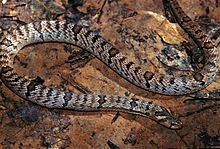Oligodon fasciolatus
| Oligodon fasciolatus | |
|---|---|

| |
| Scientific classification | |
| Domain: | Eukaryota |
| Kingdom: | Animalia |
| Phylum: | Chordata |
| Class: | Reptilia |
| Order: | Squamata |
| Suborder: | Serpentes |
| Family: | Colubridae |
| Genus: | Oligodon |
| Species: | O. fasciolatus |
| Binomial name | |
| Oligodon fasciolatus (Günther, 1864) | |
| Synonyms[2] | |
Oligodon fasciolatus, commonly known as the small-banded kukri snake or the fasciolated kukri snake, is a species of snake in the family Colubridae.[2] The species is native to Southeast Asia. This snake uniquely eviscerates live poisonous toads, Duttaphrynus melanostictus (Asian common toads), to avoid toxic white liquid the toad secretes.[3]
- Eating an Asian common toad
- Eating a banded bullfrog
Geographic range
O. fasciolatus is found in southeastern Myanmar, Thailand, Cambodia, Laos, and Vietnam.[1][2]
Habitat
The preferred natural habitat of O. fasciolatus is forest.[1]
Description
O. fasciolatus may attain a total length of 115 cm (45 in).[4]
Reproduction
O. fasciolatus is oviparous.[2]
References
- ^ a b c Thy N; Chan-Ard T; Nguyen TQ (2012). "Oligodon fasciolatus ". IUCN Red List of Threatened Species. 2012. doi:10.2305/IUCN.UK.2012-1.RLTS.T192038A2031648.en.
- ^ a b c d Oligodon fasciolatus at the Reptarium.cz Reptile Database. Accessed 23 December 2018.
- ^ Fox, Alex (2 October 2020). "This Snake Slurps Organs of Living Toads in Grisly Feeding Strategy". Smithsonian. Retrieved 12 October 2020.
- ^ Bringsøe et al. (2020).
Further reading
- Günther ACLG (1864). The Reptiles of British India. London: The Ray Society. (Taylor and Francis, printers). xxvii + 452 pp. + Plates I-XXVI. (Simotes fasciolatus, new species, pp. 218–219 + Plate XX, figure B, two views of head).
External links
- See also Duttaphrynus melanostictus for:
- Bringsøe H, Suthanthangjai M, Suthanthangjai W, Nimnuan K (2020). "Eviscerated alive: Novel and macabre feeding strategy in Oligodon fasciolatus (Günther, 1864) eating organs of Duttaphrynus melanostictus (Schneider, 1799) in Thailand". Herpetozoa 33: 157–163. Published online September 11, 2020. doi:10.3897/herpetozoa.33.e57096.
- Garcia de Jesus E (2020). "This snake rips a hole in living toads’ stomachs to feast on their organs". ScienceNews, October 2, 2020.



